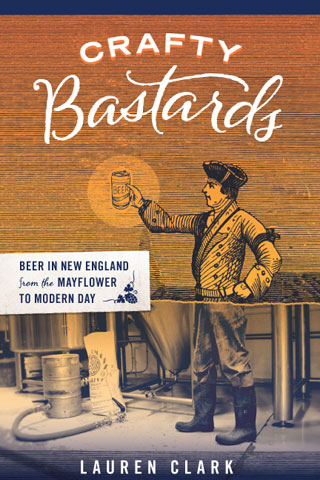February 21st, 2007
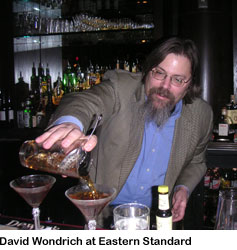
David Wondrich, drinks writer for Esquire magazine and cocktail book author, was in Boston last Thursday night for a Martini and Rossi-sponsored cocktail party at Eastern Standard. Luckily, I and a group of local bartenders got to hang with the guy for the duration of the evening. Through his writing in Esquire and as a founding member of the Museum of the American Cocktail, Wondrich has done much on the national level to revive the classic cocktail. And you may not even realize it, but the drinks you enjoy at certain Boston bars may have been pulled from his books by any number of admiring bartenders. Example: the B2C2, a champagne cocktail featured at a recent drinkboston.com event at Green Street, comes from Wondrich’s Killer Cocktails: An Intoxicating Guide to Sophisticated Drinking.
Wondrich graduated from high school in Long Island, NY, in the same class as Manhattan’s “libation goddess” Audrey Sanders, owner of the SoHo cocktail shrine Pegu Club. Up until about nine years ago, he was an English professor at New York University who was experimenting with making his own absinthe and mixing vintage cocktails. He contacted Esquire’s editor one day proposing to revive the magazine’s cocktail and party guidebooks. (These books were essential tools of the American bon vivant’s trade before that breed of gentleman was unfairly branded a limp-wristed elitist by Bud Lite-swilling NASCAR Dads.) The editor liked the idea, and Wondrich eventually switched to a writing career that allowed him to fully pursue his hobby.
Our evening’s topics of conversation included
- unusual cocktail strainers (Beyond the Hawthorne and the Julep — ask bartender Ben Sandrof about these strange implements.)
- homemade bitters and defunct brands of bitters (Wondrich once made an unusual batch of bitters with Ardbeg single-malt scotch for a scotch-based cocktail event he presided over. For the record, he prefers Angostura and Fee Brothers over other kinds of aromatic bitters, including the old brands, like Boker’s and Abbott’s, that are often extolled by cocktail enthusiasts.)
- beer geeks vs. wine snobs (“Wine snobs are critics. Beer geeks are reverent,” summed up Portland, ME bartender and MOTAC board member John Myers.)
- the continued, tragic popularity of Cosmopolitans and Grey Goose vodka
- the best bar in midtown Manhattan (Keen’s Steakhouse, a century-old establishment whose atmosphere, says Wondrich, makes up for your mediocre Canadian Club-based Manhattan)
- the disappearance of independent bookstores in downtown Boston (Wondrich planned to take the Red Line out to Davis Square in Somerville the next morning to shop for books at McIntyre and Moore’s.)
- the elegant simplicity of the gin-based Aviation cocktail (below).
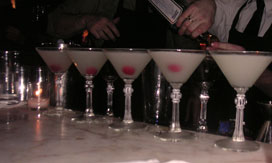
Permalink | No Comments | Filed under Boston bars, Events |
February 14th, 2007
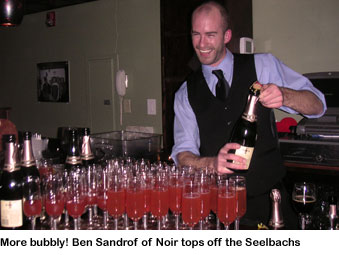
What better way to spend a Monday night in February than at a cozy neighborhood restaurant drinking champagne cocktails mixed by some of Boston’s best bartenders? That’s the sound reasoning that brought 60+ people to Green Street last night for drinkboston.com’s sold-out champagne cocktail party. Misty Kalkofen of Green Street and the B-Side Lounge, Ben Sandrof of Noir, Dylan Black of Green Street and John Gertsen of No. 9 Park mixed four distinctive classic cocktails using champagne: the Diamond Fizz, the Black Velvet, the B2C2 and the Seelbach (recipes below). Not only that, they visited each and every table in the room, explaining the drinks’ origins (or alleged origins, given that the history of cocktails is usually as unverifiable as the provenance of traditional folk songs). The evening was festive and informative — well worth the price of a small headache on Tuesday morning.
To get on the email list for future drinkboston.com events, email drinkboston at comcast dot net.
 The cocktails
The cocktails
B2C2
1 oz each of brandy, Benedictine and Cointreau shaken over ice and strained. Top with champagne.
Misty learned of this drink from David Wondrich’s Killer Cocktails: An Intoxicating Guide to Sophisticated Drinking. It was “created by American intelligence officers at the end of WWII. They had all of these wonderful goods that had been looted from the French by the Germans and then left behind during the Germans’ retreat,” she says. Luxurious bubbles.
Diamond Fizz
2 oz gin, 1 oz lemon juice and 1/2 tsp powdered sugar shaken over ice and strained. Top with champagne.
A dressed-up gin fizz (which uses seltzer instead of champagne). Also similar to the French 75, only it contains less sugar and no garnish. The Cocktail Database recipe calls for a highball glass with ice, but we served it straight up in a saucer. Delicious either way.
Black Velvet
1/2 stout and 1/2 champagne in a wine glass or flute.
Said to have been created at London’s Brooks Club in 1861 during mourning over Prince Albert’s death. Also called the Bismarck, as the drink was a favorite of German statesman Otto von Bismarck. Dylan used Mackeson’s Stout for this drink. Dark and rich.
Seelbach
1 oz bourbon, 1/2 oz Cointreau and 7 dashes each Angostura and Peychaud’s bitters poured into a flute and stirred. Top with champagne.
Invented at the Seelbach Hotel in Louisville, Kentucky, circa 1917. The recipe was lost, probably during Prohibition, until being rediscovered by the hotel in 1995 and later printed in Gary and Mardee Regan’s New Classic Cocktails. This is one of the great whiskey drinks.
Permalink | No Comments | Filed under Bartenders, Beer, Brandy, Champagne, Cocktails, Events, Gin, Liqueur |
February 10th, 2007
 A couple of years ago, in an article called “Light, Crisp and Unavailable,” I complained about the lack of flavorful but light-bodied, moderate-in-alcohol craft beers. Craft brewers and beer drinkers were then and, for the most part, still are obsessed with “extreme beers” high in alcohol, loaded with hops, and heavy with malty sweetness. Some of these beers are exceptional and fun to drink. But what about when you’re looking for an everyday beer with great character? Where is the American — preferably local — equivalent of a German helles or kolsch, an English ordinary bitter, or the dry Belgian ale DeKoninck? Well, my prayers have finally been answered. There is a six-pack of Beer of the Gods in my fridge.
A couple of years ago, in an article called “Light, Crisp and Unavailable,” I complained about the lack of flavorful but light-bodied, moderate-in-alcohol craft beers. Craft brewers and beer drinkers were then and, for the most part, still are obsessed with “extreme beers” high in alcohol, loaded with hops, and heavy with malty sweetness. Some of these beers are exceptional and fun to drink. But what about when you’re looking for an everyday beer with great character? Where is the American — preferably local — equivalent of a German helles or kolsch, an English ordinary bitter, or the dry Belgian ale DeKoninck? Well, my prayers have finally been answered. There is a six-pack of Beer of the Gods in my fridge.
Beer of the Gods is a hybrid of two German ale styles. It’s made with the pale pilsner malt used in Cologne’s golden ale, Kölsch, and the spicy noble hops used in Dusseldorf’s Alt beer. Extra aroma hops are added during a crucially lengthy lagering (cold-aging) stage. The result is a light, crisp, refreshingly hoppy, exquisitely balanced beer.
Will Shelton, who with his brother Dan owns the Shelton Brothers beer-import company in Belchertown, MA, brews Beer of the Gods at the Paper City Brewery in Holyoke, MA, under the name High & Mighty Brewing Co. In addition to Beer of the Gods, he produces XPA (extra-pale ale), an American pale ale that’s hoppy without being overly citrusy or herb-y. Brewing these beer styles makes total sense for Will, given that he and Dan have for years bucked the extreme-beer trend by importing traditional, nuanced beers from very small breweries in Europe, the U.K. and Canada. They are known for regularly pissing off the craft-beer cognoscenti by, for instance, denouncing many strong Belgian ales as much too sweet (Duvel, Delirium Tremens) and dismissing the armchair connoisseurs behind the beer-rating system on BeerAdvocate.com. But their criticisms have legitimacy, because they know good beer. (By the way, these are the guys behind Santa’s Butt Winter Porter, an English beer whose label caused some regulatory controversy.)
And now they don’t just import good beer, they make it, too. In greater Boston you can find High & Mighty beers at Downtown Wine and Spirits in Davis Square, Somerville. Call first to make sure they’re in stock, though: 617-625-7777.
Permalink | No Comments | Filed under Beer |
February 7th, 2007
Today’s New York Times features a great, quote-rich article on London’s cocktail scene, The Best Town to Make an Upper Lip Stiff. I want to point to an excerpt that encapsulates the philosophy and mission of drinkboston.com:
Of course, lemon grass and ginger syrup in the hands of the wrong bartender can lead to disaster. Few people understand this better than Robbie Bargh, the creative director of the Gorgeous Group, the consulting concern behind many of London’s splashiest new joints. An ebullient, opinionated former mixologist and bar manager with 16 years’ experience, Mr. Bargh said he has no time for “egotistical demigods” behind the bar who don’t bother with the fundamentals.
“We’re going through a big backlash to over-mixology,” he said. “I think like a chef. Like a chef, you can’t deliver innovation without renovation. You can’t modernize without a basic understanding of what it takes to make a great classic drink — why a Negroni is so different made with Aperol rather than Campari.”
In short, if you go to a bar where the bartender doesn’t know how to make a Negroni but instead offers you an Earl Grey-Chocolate-Chipotle Pepper-tini, pause and ask yourself: would I spend my money at a restaurant where the chef could whip up all manner of trendy foams and sculptural appetizers but couldn’t grill a steak to save his life? If your answer’s no, then move on to the next bar.
Permalink | 1 Comment | Filed under Booze in the news, Cocktails |
February 4th, 2007
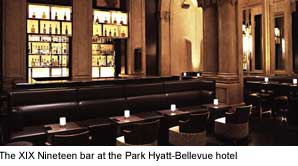
Meet Me in the Bar: Classic Drinks from America’s Historic Hotels, by Thomas Connors, is a travel guide for the cocktail tourist. The book lovingly describes a couple dozen or so grand, old hotel bars, along with signature drinks concocted therein. Representing Boston are the Oak Bar at the Fairmont Copley Plaza and the bar at the Ritz-Carlton. Philadelphia, where we spent a recent weekend, has the Library Lounge in the Park Hyatt at the Bellevue. Or at least it did in 2003, when Meet Me in the Bar was published. We should’ve called first.
Ironically, Connors writes of the Library Lounge, “These days, as hotel operators jazz up old properties for a younger clientele, it’s possible to walk into a sober-looking hotel and discover that that sensible bar you once knew is now a scene. Luckily, the 19th-floor Library Lounge is nothing like that.” He goes on to describe its intimate scale, its rich woodwork, its fireplace and its book-lined walls. Sigh. That would have been great. The brand new bar that we found in its place, XIX (aka Nineteen), has most decidely been “jazzed up for a younger scene.” The only thing that remains from the Library Lounge is a large painted portrait of a well-to-do Quaker ice skating.
XIX is a posh but beige bar that could be in any first-class hotel in America. Sure, it’s a nice, polished-marble oasis high above the city, and the bartender was a welcoming and competent guy who had just moved up from Baltimore. But he had never heard of a Clover Club. That drink — gin with egg white, lime, raspberry syrup and bitters — originated at the Bellevue, and Connors calls it “the spiritous equivalent of the famous Philly cheese steak.” Unfortunately, the Clover Club seems to have gone the way of the books that once lined the walls of this bar. Vodka is now the dominant spirit on the cocktail menu, as it is in every other posh hotel bar in the country. At least they had Yuengling Lager.
Permalink | 2 Comments | Filed under Philadelphia |



 The cocktails
The cocktails A couple of years ago, in an article called “Light, Crisp and Unavailable,” I complained about the lack of flavorful but light-bodied, moderate-in-alcohol craft beers. Craft brewers and beer drinkers were then and, for the most part, still are obsessed with “extreme beers” high in alcohol, loaded with hops, and heavy with malty sweetness. Some of these beers are exceptional and fun to drink. But what about when you’re looking for an everyday beer with great character? Where is the American — preferably local — equivalent of a German helles or kolsch, an English ordinary bitter, or the dry Belgian ale DeKoninck? Well, my prayers have finally been answered. There is a six-pack of Beer of the Gods in my fridge.
A couple of years ago, in an article called “Light, Crisp and Unavailable,” I complained about the lack of flavorful but light-bodied, moderate-in-alcohol craft beers. Craft brewers and beer drinkers were then and, for the most part, still are obsessed with “extreme beers” high in alcohol, loaded with hops, and heavy with malty sweetness. Some of these beers are exceptional and fun to drink. But what about when you’re looking for an everyday beer with great character? Where is the American — preferably local — equivalent of a German helles or kolsch, an English ordinary bitter, or the dry Belgian ale DeKoninck? Well, my prayers have finally been answered. There is a six-pack of Beer of the Gods in my fridge.
